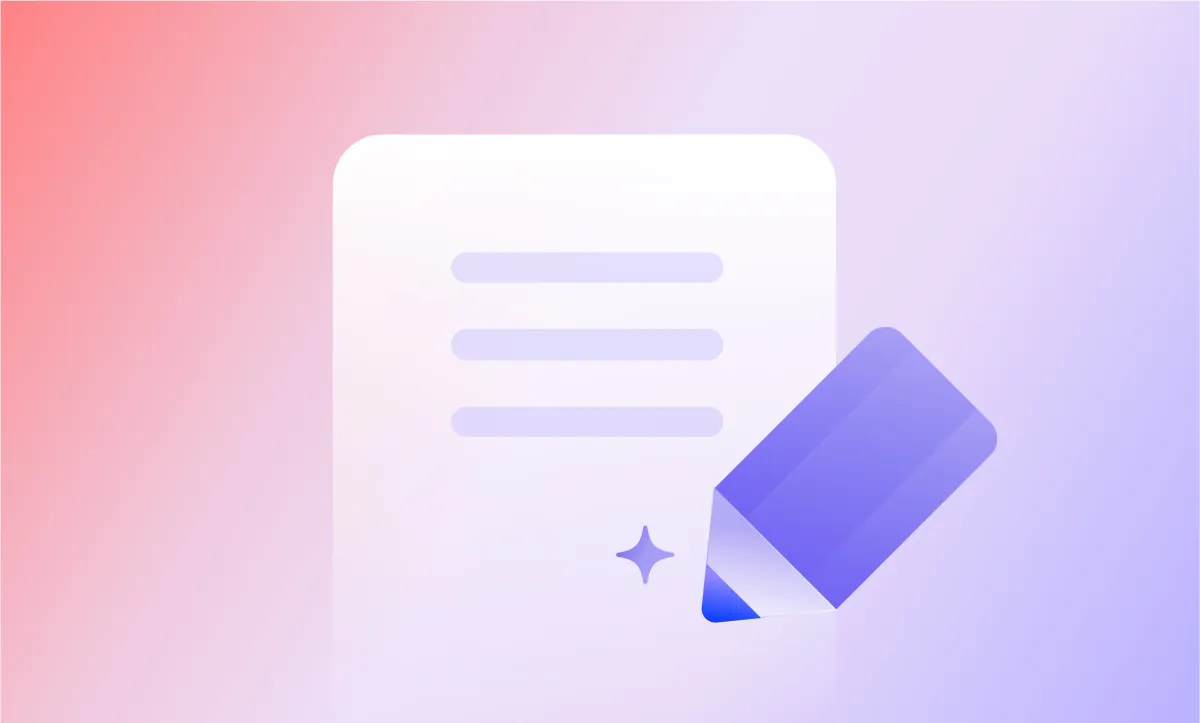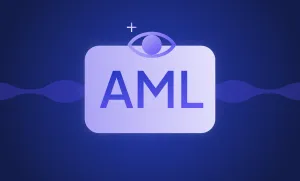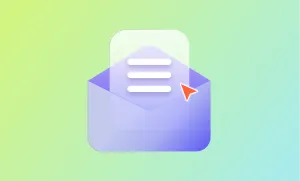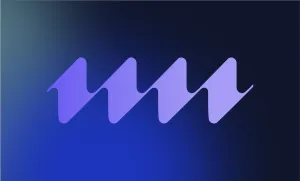If you’ve ever sat down in front of the mic, hit record, and suddenly had no idea what to say next, you probably weren’t as prepared as you thought.
The truth is, although it feels counterintuitive, half the reason so many of your favorite podcasts sound effortlessly improvised is because the hosts actually have a well-organized script guiding them along the way.
In this blog post, we’ll walk you through how to write a podcast script that keeps you confident, structured, and still totally natural on air.
Key takeaways
- A script is a flexible guide, not a rigid word-for-word read
- Start by defining your goal and audience before writing
- Choose a format that matches your show’s style and structure
- Use timing notes and cues to keep the delivery smooth
- Leave space for spontaneity so your voice feels authentic
How to write a podcast script: Key steps
A good script doesn’t lock you into reading word-for-word. Instead, it gives you a clear path to follow so you can stay focused, hit your main points, and keep the flow natural. Here are the core steps to writing one that works.
1. Define your goal and audience
Before you write a single line, decide what you want listeners to walk away with. Are you trying to entertain, inform, or inspire? Knowing your objective shapes your tone and structure. Pair that with a clear picture of who your audience is, their interests, expectations, and even attention span, and you’ll know what kind of script you need.
2. Choose your format
Podcasts come in many styles: solo commentary, interviews, panel discussions, or storytelling. Each format demands a slightly different script. An interview outline, for example, may focus on key questions and transitions, while a narrative podcast might require scene setting, voiceover notes, and pacing cues. Decide on your format early, and your script will naturally follow.
3. Build a strong outline
Think of your outline as a roadmap. Break your episode into sections: intro, main body, and conclusion. Under each, jot down the key points or story beats you want to cover. This makes the writing process smoother and prevents you from wandering off track mid recording.
- Intro: Grab attention quickly and set expectations.
- Body: Organize your arguments, stories, or questions into a logical flow.
- Conclusion: Summarize the takeaways and close with a call to action.
4. Write for the ear
Podcast scripts should sound conversational, not like a research paper. Use short sentences, contractions, and natural phrasing. If a sentence feels clunky when read aloud, rework it. A quick trick: read your draft out loud and adjust anything that feels stiff. Remember, your audience is listening, not reading.
5. Add timing notes and stage directions
Scripts aren’t just words, they’re guides for pacing. Add small notes about pauses, tone changes, or sound effects if your podcast uses them. For example: “[pause for effect]” or “[insert transition music].” These cues make your delivery smoother and help your editor know what’s coming next.
6. Keep it flexible
Even the best script should leave room for spontaneity. Add bullet points or optional notes where you might riff, share a story, or react to your co host. This keeps your show dynamic and authentic while still giving you structure.
7. Revise and trim
A common mistake is overwriting. Once your draft is ready, cut anything that doesn’t serve your main point. Tightening your script makes the episode punchier and keeps listeners engaged from start to finish.
Podcast script template
Every podcaster has their own style, but having a structured script template helps you stay consistent from one episode to the next.
A good template keeps you organized without taking away the freedom to ad-lib and let conversations flow naturally.
Here’s a quick snippet of what a podcast script template might look like:
Episode intro (1–2 minutes)
- Host greeting
- Short teaser of the episode topic or guest
- Quick hook to grab attention
- Mention of the podcast name and episode title
Main discussion
- Transition into first topic or question
- Three to four key talking points
- Supporting story, fact, or example
- Optional sound or music cue
Closing
- Recap of the main takeaways
- Thank the guest or co-host (if applicable)
- Call to action: subscribe, review, or visit your website
- Teaser for the next episode
This is just a starting point; you can expand or trim sections depending on your format. For interviews, you may want a longer list of questions, while for a solo show, you may focus more on storytelling notes.
📌 Want the full version? Download our complete podcast script template and adapt it to your own episodes.
FREE Template here
Podcast script examples
Although you can always start with a standard template, keep in mind that the structure of your podcast will vary depending on the format you choose. A solo episode won’t look the same as a guest interview or a narrative show. To make this easier, here are some common podcast script examples summarized for quick reference.
Solo podcast script example
Intro
“Hi, welcome to [Podcast Name]. I’m your host, [Name], and today we’re diving into…”
Body
- Key talking points written as bullet notes
- Personal stories or examples added in parentheses
- Notes for timing cues or pauses
Outro
- Quick recap of the episode
- Call to action (subscribe, review, follow on socials)
This type of script is short and flexible, giving the host plenty of room to add personality while still staying on track.
Interview podcast script example
Intro
“Today I’m joined by [Guest Name], [Guest Title]. We’ll be talking about…”
Questions / talking points
- Can you tell us about your background and how you got started?
- What inspired you to work on [topic]?
- What’s one challenge you faced and how did you overcome it?
- Where do you see [industry/topic] heading in the future?
Outro
“Thanks again to [Guest Name] for joining us. If you enjoyed today’s conversation…"
Interview scripts often act as structured outlines rather than word-for-word scripts, helping the conversation stay focused while leaving space for natural dialogue.
Narrative podcast script example
Intro narration
Scene-setting line: “It was a cold January morning when everything changed…”
Body
- Narration sections written in full sentences
- Notes for sound effects or background music
- Dialogue cues if multiple voices are involved
Outro narration
Wrap-up line: “That was [episode title]. Join us next week as we explore…”
Narrative podcasts usually need more detailed scripts since pacing, timing, and sound design play a bigger role.
When to use a podcast script generator
Not every podcaster writes every line by hand. Sometimes, a script generator can save time, spark ideas, or help organize your thoughts. Here are a few scenarios where using one makes sense:
- You’re short on time: If you need to produce episodes quickly, a script generator can outline talking points or draft full scripts in minutes. This helps you stay consistent without spending hours writing.
- You’re struggling with writer’s block: Even experienced podcasters hit creative roadblocks. A generator can provide prompts, sample questions, or topic suggestions to get the conversation flowing.
- You want a polished structure: Generators can give you a professional framework that includes intros, transitions, and outros. This is especially helpful if you’re just starting out or experimenting with a new format.
- You’re planning multiple episodes: When producing a series, a script generator can help maintain consistency across episodes, ensuring similar pacing, tone, and segment flow.
- You want to experiment with new formats: Curious about switching from solo commentary to interviews, or trying a narrative style? A generator can produce multiple script variations, giving you ideas without committing hours of writing.
While a script generator is a powerful tool, it works best when combined with your voice and style. Think of it as a toolbox that helps you map out your episode, while you decide which ideas to highlight, skip, or expand on.
Podcast script writing tips
Finally, here are some practical tips to help you craft scripts that sound natural and keep your episodes flowing smoothly. Use them as a checklist when polishing your draft.
1. Write for the ear, not the eye
When you draft your script, imagine a listener with headphones on rather than a reader scanning text. Keep sentences short, conversational, and easy to follow when spoken aloud. What looks fine on the page may sound robotic once recorded. A good test is to read it out loud: if you stumble or run out of breath, the sentence is too long.
2. Balance structure with spontaneity
A script should keep you on track, but it should not cage your personality. Think of it as a roadmap: clear enough to guide you from intro to outro, yet flexible enough to let you add an extra thought or react to your co-host in the moment. Mark the essential beats, intro, transitions, calls to action, then allow breathing room for natural flow.
3. Use stage directions sparingly
Stage directions can be helpful, especially when you want to remind yourself to pause, change tone, or add emphasis. But if your script is full of brackets and side notes, it becomes harder to read smoothly. Instead, reserve cues for key moments that truly impact delivery. For example, a [pause] before revealing an important fact gives weight to your words without cluttering the rest of the script.
4. Keep your audience in mind
Scripts are not just about what you want to say; they are about what your listeners need to hear. Visualize your ideal audience member: their interests, challenges, and expectations. Write with them in mind, and your language will naturally become more focused and engaging. This also helps you avoid filler content, since every line is anchored to listener value.
5. Rehearse, then trim
The best scripts are written twice: once on paper, and once during rehearsal. After a practice read, you will quickly spot phrases that feel stiff or sections that drag on too long. Cut the fat, tighten the flow, and highlight moments where your delivery shines. This last edit often makes the difference between a decent episode and a compelling one.
Create the perfect podcast with Podcastle
A good script sets the foundation, but the right tools bring it to life. With Podcastle, you can take your script from draft to a fully produced episode without juggling multiple apps.
Here are five features that make Podcastle the perfect companion for your script:
- Teleprompter: Upload your script and read it smoothly while recording without losing eye contact.
- Recording studio: Capture high-quality audio and video, whether you’re solo or inviting remote guests.
- AI voice enhancements: Clean up background noise and polish your sound automatically.
- Multitrack editing: Edit each speaker track separately to tighten timing and cut mistakes.
- One-click publishing: Export your episode or share it directly to platforms once you’re done.
Ready to turn your script into a podcast? Get started with Podcastle today.








